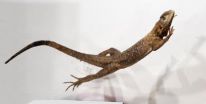Identifying sloth species at a genetic level
2012-01-05
(Press-News.org) Identifying species, separating out closely related species and managing each type on its own, is an important part of any animal management system. Some species, like the two types of two-toed sloth, are so close in appearance and behavior that differentiation can be challenging. Conservation researchers at San Diego Zoo Global's Institute of Conservation Research have developed a mechanism for identifying these reclusive species from each other.
"Species identification of two-toed sloths has always been problematic in the wild and captivity due to their large overlap in external morphology. " said Oliver Ryder Ph.D., Director of Genetics for San Diego Zoo Global's Institute of Conservation Research. "Through this effort we have described a low-cost easy-to-use molecular tool for species identification that will help to improve management of two-toed sloth species so that we can ensure that they are properly represented on the ark of rare and endangered species."
The study, published in the December 2011 issue of Zoo Biology, describes a PCR-based technique that allows species identification of two-toed sloths without requiring sequencing, by using a mitochondrial marker (COI gene) and restriction enzyme assay. It also reports intra- and inter-specific patterns of chromosome variation in captive two-toed sloths. The chromosome number in Hoffman's two-toed sloths showed low variation ranging only between 50 and 51. In contrast, Linnaeus's two-toed sloths appeared to vary widely, with diploid numbers ranging from 53 to 67, suggesting distinct geographic groups.
INFORMATION:
The San Diego Zoo Institute for Conservation Research is dedicated to generating, sharing and applying scientific knowledge vital to the conservation of animals, plants and habitats worldwide. The work of the Institute includes onsite research efforts at the San Diego Zoo and the San Diego Zoo Safari Park (historically referred to as Wild Animal Park), laboratory work at the Arnold and Mabel Beckman Center for Conservation Research, and international field programs involving more than 235 researchers working in 35 countries. In addition to the Beckman Center for Conservation Research, the Institute also operates the Anne and Kenneth Griffin Reptile Conservation Center, the Frozen Zoo® and Native Seed Gene Bank, the Keauhou and Maui Hawaiian Bird Conservation Centers, Cocha Cashu Biological Research Station and the Desert Tortoise Conservation Center. The Zoo also manages the 1,800-acre San Diego Zoo Safari Park, which includes a 900-acre biodiversity reserve, and the San Diego Zoo. The important conservation and science work of these entities is supported in part by The Foundation of the Zoological Society of San Diego.
END
ELSE PRESS RELEASES FROM THIS DATE:
2012-01-05
In a study that investigates the challenges of disseminating clinical research findings in peer-reviewed biomedical journals, Yale School of Medicine researchers have found that fewer than half of a sample of trials primarily or partially funded by the National Institutes of Health (NIH) were published within 30 months of completing the clinical trial.
These findings appear in the January issue of the British Medical Journal, which focuses on the topic of unpublished evidence.
"When research findings are not disseminated, the scientific process is disrupted and leads ...
2012-01-05
Intellectsoft celebrates the New Year 2012 with the launch of a brand new website. Last year the company celebrated their fourth birthday, successfully delivered more than 100 projects and entered Scandinavian mobile development market. Intellectsoft couldn't but commemorate their significant progress with the launch of a new marvellous corporate website. As with any business there is, you eventually outgrow your old website however good it is.
Intellectsoft decided to renew the design and content of http://www.intellectsoft.co.uk, so that it corresponds precisely to ...
2012-01-05
PITTSBURGH -- The delivery of pharmaceuticals into the human body or the storage of voluminous quantities of gas molecules could now be better controlled, thanks to a study by University of Pittsburgh researchers. In a paper published online today in Nature Communications, a team of chemists and colleagues from Pitt's Kenneth P. Dietrich School of Arts and Sciences and the Pitt School of Medicine and Northwestern and Durham universities have posed an alternative approach toward building porous materials.
Working with metal-organic frameworks—crystalline compounds comprising ...
2012-01-05
ST. PAUL, Minn. – A new guideline issued by the American Academy of Neurology recommends doctors use caution when choosing seizure drugs for people with HIV/AIDS to avoid potential drug interactions. The guideline, which was co-developed with the International League Against Epilepsy (ILAE), is published in the January 4, 2012, online issue of Neurology®, the medical journal of the American Academy of Neurology and in Epilepsia, the journal of the ILAE.
Seizures and seizure disorders are common in people infected with HIV, with more than one in 10 patients experiencing ...
2012-01-05
Following the tremendous success of the Pets in the Classroom Grant Program to date and numerous requests from teachers of 7th & 8th grade classes to be eligible for funding, the Pet Care Trust Board has agreed to expand the program's reach to those grades beginning in 2012.
Established by the Pet Care Trust in 2009, Pets in the Classroom has provided grants to Pre-Kindergarten through Sixth grade teachers to purchase or adopt a new pet and required equipment or to support existing classroom pets. The Pets in the Classroom program has seen over 7,000 grant requests ...
2012-01-05
EAST LANSING, Mich. —New guidelines from the American Academy of Neurology will help physicians better choose seizure drugs for people on HIV/AIDS medication, avoiding deadly drug interactions and preventing critical anti-HIV drugs from becoming less effective, possibly leading to a more virulent strain of the disease.
Michigan State University's Gretchen Birbeck – who spends several months each year in the sub-Sahara African nation of Zambia researching epilepsy, HIV /AIDS and cerebral malaria – is the lead author of the medical guideline, which was co-developed with ...
2012-01-05
William Peace University (http://www.peace.edu), a private four-year university located in downtown Raleigh, has announced that the university will sponsor the Greater Raleigh Chamber of Commerce's Chamber Executive Women's Luncheon on Thursday, Jan. 12 at the Embassy Suites Hotel, located at 201 Harrison Oaks Blvd. in Cary, N.C. from 11:30 a.m. until 1:30 p.m. The luncheon will cover the topic of "Women in Politics: Heeding the Call of Public Service." A panel of elected female officials will provide personal and professional insights into the political arena ...
2012-01-05
Advanced miniature refrigeration and environmental control technology developer and manufacturer Aspen Systems, Inc. has launched a new website designed to help companies and government agencies find specialized cooling solutions for advanced commercial, industrial and military applications.
According to Aspen Systems Vice President Glenn Deming, the new website comes as part of an integrated business development effort aimed at expanding further into military and commercial markets, in addition to gaining increased awareness of the companies capabilities as a supplier ...
2012-01-05
An exact determination of expected body weight for adolescents based on age, height and gender is critical for diagnosis and management of eating disorders such as anorexia nervosa and bulimia. However, there are no clear guidelines regarding the appropriate method for calculating this weight in children with such disorders.
In a study to be published online Jan. 4, 2012, in the journal Pediatrics, researchers from the University of Chicago, the Harvard School of Public Health and the University of Rochester Medical Center compared three common methods for calculating ...
2012-01-05
Leaping lizards have a message for robots: Get a tail!
University of California, Berkeley, biologists and engineers including undergraduate and graduate students studied how lizards manage to leap successfully even when they slip and stumble, and found that swinging the tail upward is the key to preventing a forward pitch that could send them head-over-heels into a tree.
The scientists subsequently added a tail to a robotic car they named Tailbot and discovered that it's not as simple as throwing your tail in the air. Robots and lizards have to adjust the angle of ...
LAST 30 PRESS RELEASES:
[Press-News.org] Identifying sloth species at a genetic level

